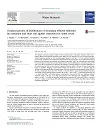The Shafdan reclamation project facility (Tel Aviv, Israel) practices soil aquifer treatment (SAT) of secondary effluent with hydraulic retention times (HRTs) of a few months to a year for unrestricted agricultural irrigation. During the SAT, the high oxygen demand (>40 mg L−1) of the infiltrated effluent causes anoxic conditions and mobilization of dissolved manganese from the soil. An additional emerging problem is the occurrence of persistent trace organic compounds (TrOCs) in reclaimed water that should be removed prior to reuse. An innovative hybrid process based on biofiltration, ozonation and short SAT with ∼22 d HRT is proposed for treatment of the Shafdan secondary effluent to overcome limitations of the existing system and to reduce the SAT's physical footprint. Besides efficient removal of particulate matter to minimize clogging, coagulation/flocculation and filtration (5–6 m h−1) operated with the addition of hydrogen peroxide as an oxygen source efficiently removed dissolved organic carbon (DOC, to 17–22%), ammonium and nitrite. This resulted in reduced effluent oxygen demand during infiltration and oxidant (ozone) demand during ozonation by 23 mg L−1 and 1.5 mg L−1, respectively. Ozonation (1.0–1.2 mg O3 mg DOC−1) efficiently reduced concentrations of persistent TrOCs and supplied sufficient dissolved oxygen (>30 mg L−1) for fully oxic operation of the short SAT with negligible Mn2+ mobilization (<50 μg L−1). Overall, the examined hybrid process provided DOC reduction of 88% to a value of 1.2 mg L−1, similar to conventional SAT, while improving the removal of TrOCs and efficiently preventing manganese dissolution.
